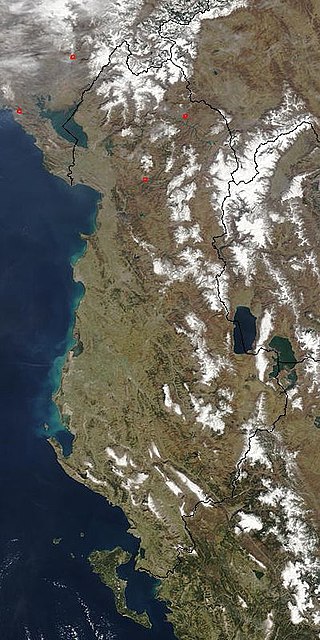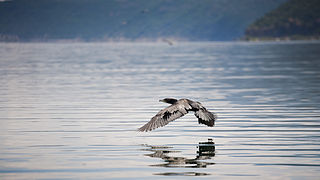This article needs additional citations for verification .(February 2024) |
The Macedonian Ecological Society (MES) was founded in 1972, [1] [2] in what was then known as the Socialist Republic of Macedonia.
This article needs additional citations for verification .(February 2024) |
The Macedonian Ecological Society (MES) was founded in 1972, [1] [2] in what was then known as the Socialist Republic of Macedonia.

Albania is a country in southeastern Europe that lies along the Adriatic and Ionian Seas, with a coastline spanning approximately 476 km (296 mi). Situated on the Balkan Peninsula, it is one of the most mountainous countries in Europe. It is bounded by Montenegro to the northwest, Kosovo to the northeast, North Macedonia to the east and Greece to the southeast and south.

North Macedonia is a country situated in southeastern Europe with geographic coordinates 41°50′N22°00′E, bordering Kosovo and Serbia to the north, Bulgaria to the east, Greece to the south and Albania to the west. The country is part of the wider region of Macedonia and makes up most of Vardar Macedonia. The country is a major transportation corridor from Western and Central Europe to Southern Europe and the Aegean Sea. North Macedonia is a landlocked country but has three major natural lakes: Lake Ohrid, Lake Prespa and Lake Dojran. It has a water area of 857 km2, while its land area is 24,856 km2.

The Eurasian lynx is one of the four extant species within the medium-sized wild cat genus Lynx. It is widely distributed from Northern, Central and Eastern Europe to Central Asia and Siberia, the Tibetan Plateau and the Himalayas. It inhabits temperate and boreal forests up to an elevation of 5,500 m (18,000 ft). Despite its wide distribution, it is threatened by habitat loss and fragmentation, poaching and depletion of prey.

Pogradec is the eleventh most populous city in Albania and the capital of the eponymous municipality. It is located on a narrow plain between two mountain chains along the southwestern banks of the Lake of Ohrid. Its climate is profoundly influenced by a seasonal Mediterranean and continental climate. The total population is 61,530, of which 20,848 in the municipal unit Pogradec.

Lake Ohrid is a lake which straddles the mountainous border between the southwestern part of North Macedonia and eastern Albania. It is one of Europe's deepest and oldest lakes, with a unique aquatic ecosystem of worldwide importance, with more than 200 endemic species.

The Lake Prespa is located on the tripoint of North Macedonia, Albania and Greece. It is a system of two lakes separated by an isthmus: the Great Prespa Lake, divided between the three countries, and the Little Prespa Lake, mostly within Greece. They are the highest tectonic lakes in the Balkans, at an elevation of 853 metres (2,799 ft).

Prespa is a region shared between North Macedonia, Greece, and Albania. It shares the same name with the two Prespa lakes which are situated in the middle of the region. The largest town is Resen in North Macedonia with 9,000 inhabitants.

Baba, also known by the name of its highest peak, Pelister, is a mountain in North Macedonia. The Pelister peak overlooks the city of Bitola. Baba is the third highest mountain in North Macedonia. Other peaks besides Pelister are Dva Groba, Veternica, Musa, Ržana, Široka, Kozji Kamen, Griva and Golema Čuka in North Macedonia, and Belavoda, Kirko. The Baba massif splits up the rivers in the region, so that they either flow towards the Adriatic Sea.

The Bulgarians in Albania live mostly in the areas of Mala Prespa, Gollobordë and Gora. Ethnic identity can be fluid among Albania's Slavophonic population, who might identify as Albanian, Bulgarian or Macedonian, depending on the circumstances. Between 2001 and 2016, around 4,470 Albanian nationals applied for a Bulgarian citizenship and over 2,600 of them were granted one. The Bulgarian minority was recognized by the Albanian government in October 2017. In the 2023 Albania census, 7,057 people declared themselves to be Bulgarians making them the largest Slavophone population in Albania.

The Balkan lynx is a subspecies of the Eurasian lynx in the genus Lynx. It is found in Albania, Kosovo and western North Macedonia, with smaller populations in Montenegro. It is considered a national symbol in North Macedonia and appears on the 5-denar coin.

North Macedonia, officially the Republic of North Macedonia, is a landlocked country in Southeast Europe. It shares land borders with Greece to the south, Albania to the west, Bulgaria to the east, Kosovo to the northwest and Serbia to the north. It constitutes approximately the northern third of the larger geographical region of Macedonia. Skopje, the capital and largest city, is home to a quarter of the country's population of 1.83 million. The majority of the residents are ethnic Macedonians, a South Slavic people. Albanians form a significant minority at around 25%, followed by Turks, Roma, Serbs, Bosniaks, Aromanians and a few other minorities.

Shebenik National Park is a national park in eastern Albania adjacent to the border with North Macedonia. It encompasses 34,507.9 hectares (345.079 km2) and is specifically marked by a mountainous landscape supplied with glacial lakes, valleys, dense coniferous and deciduous forests and alpine meadows and pastures. Elevations in the park vary from 300 metres to over 2,200 metres above the Adriatic at the peak of Shebenik and Jabllanica, hence the name. It dwells a number of endangered species that are fast becoming rare in Southern Europe, including the brown bear, gray wolf and Balkan lynx. The abundance in wildlife can in part be explained by the variety of vegetation types and remote location.

The Central Mountain Region is a physiogeographical region encompassing the central and eastern edge of Albania. It comprises the mountainous inland extending all the way from the valley of Drin and the mountains of Sharr, Skanderbeg, Korab, and Shebenik-Jabllanicë, through the lakes of Ohrid and Prespa, until it reaches the village of Ersekë and the mountains of Pindus close to the border between the country and Greece.

Ohrid-Prespa Transboundary Biosphere Reserve is a biosphere reserve encompassing the area of Lake Ohrid and Lake Prespa, on North Macedonia and Albania.

For a small country, Albania is characterised by a considerable wealth of terrestrial and marine ecosystems and habitats with contrasting floral, faunal, and fungal species, defined in an area of 28,748 square kilometres. Most of the country is predominantly of Mediterranean character, comprehending the country's center and south, while the alpine affinity is more visible in the northeast.

Prespa National Park is a national park situated in southeastern Albania on the border triangle shared with Greece and North Macedonia. At approximately 277.5 km2 (107.1 sq mi), the park encompasses the country's sections of the Great and Small Prespa Lake. It is considerably characterised by high mountains, narrow islands, vast freshwater wetlands, salt marshes, meadows, reed beds and dense forests.

Montenegro is the smallest Balkan nation in population and second smallest in land mass. The land mass is 13,812 square kilometres with 360 square kilometres of water. Montenegro's geography ranges from mountainous forested regions in the north where larger mammals are most common. Mediterranean coastline makes up the south end of the country, forested area makes up 40.4% of the nation's landmass. The most densely populated area of the country is the south coast and the most sparsely populated is the north east section of the country. The fauna of Montenegro is predominantly shared with surrounding Balkan nations.

Over 22,500 species of wildlife have been recorded in North Macedonia. Over 10,000 of these are insects, which include 3,000 beetle species and large numbers of Lepidoptera, flies, and Hymenoptera. Aside from insects, other large arthropod groups include Chelicerata and crustaceans. Among vertebrates, more than 300 species of birds recorded, although not all nest in the country. There are over 80 species of both fish and mammals, 32 reptiles, and 14 amphibians.
The United Nations Educational, Scientific and Cultural Organization (UNESCO) Biosphere Reserves are significant institutions of international status as described in the established order of the World Network of Biosphere Reserves within the framework of the Man and the Biosphere Programme. The biosphere reserves specifically promote and support sustainable development for conservation of biological and cultural diversity.
ARCTUROS is a non-profit, non-governmental, environmental organization in Greece that is focusing on the protection of wildlife fauna and natural habitat. It was founded in 1992 with the main goal of stopping the problem of wolf and bear imprisonment, which was a common occurance at that time. It is conducting a wide range of activities, like operating wildlife sanctuaries, conducting scientific research, providing veterinary care to wild animals, reintroducing them into nature and more.